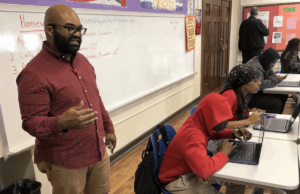How Can We Prevent High School Seniors from Dropping Out?

By: Ray McNulty & Cairen Withington
A 2013 report from the National Center for Education Statistics found more high school seniors dropped out in the 2009-2010 school year than their counterparts in any other grade. According to the study, 5.1 percent of high school seniors, or 175,806 students, dropped out during their final year – a tragedy akin to quitting a marathon at the 25th mile. What drives these seniors to drop out when they are so close to the finish line?
Although the numbers indicate that these students leave during senior year, studies show that dropping out of school is often the result of a long, cumulative process and is not a decision students make overnight. The National Dropout Prevention Center/Network notes there is no single risk factor to accurately predict who is at risk of dropping out, but when multiple risk factors are considered, the accuracy of dropout predictions increases. The Center also notes that dropping out is a process – not an event – resulting from a long period of disengagement that could last years. This disengagement could stem from health issues that make students unable to focus on their studies. Or, if female students get pregnant, they may be unable to complete their studies because they are caring for a child and may be more likely to drop out, according to the U.S. Department of Health & Human Services Office of Adolescent Health. Substance abuse can also lead to an increased risk of dropping out. The National Survey on Drug Use and Healthfound that substance abuse rates among seniors who had dropped out were higher than among those who were still in school. For example, 56.8 percent of dropouts smoked cigarettes as opposed to 22.4 percent of students who were still in school.
For some students, environmental factors and adult responsibilities prevent them from graduating high school. A study of Washington state dropouts found that the likelihood of special education, limited English and low-income students dropping out increased each year they were in school. For example, students with limited English had a 5.1 percent dropout rate in ninth grade, but a 13.4 percent dropout rate in 12th grade. Adult responsibilities can also get in the way of students graduating. They may work long hours or have siblings to care for, making it harder for them to find time to study, according to the National Dropout Prevention Center/Network . In addition, at age 18, students can drop out without parental signatures, making the process much easier and perhaps more desirable for students who may prefer to work full-time.
Given these risk factors associated with dropping out, how can school administrators in the U.S. help reduce the dropout rate for seniors? In addition to addressing issues throughout the pipeline, the key may be taking model dropout prevention programs aimed at specific grade levels, and reinventing them for seniors. For example, freshmen academies, which include specialized freshmen faculty and a dedicated team of counselors, help ninth graders transition into high school. Perhaps a program aimed at the specific challenges of the senior year could address some of the factors related to high dropout rates during this critical time. In addition, high school seniors (as well as our communities) need programs that transition them into the real world. High school graduates need to be college and career ready, meaning they are prepared to enter college or, if they choose, directly enter the workforce. College may not be for every student, but given that middle-skilled jobs make up the largest part of America’s labor market, it is vitally important to prepare students for these jobs. For some, that may mean preparing them for college, but for many, that means providing them with vocational training while they are still in high school.
Better preparing students to transition out of high school will involve several steps. It will mean preparing teachers and counselors to talk candidly with students about their futures, and coming up with education and career options that work best for them. It will mean offering students the option of a career-focused education in high school, especially since research has shown several positive outcomes to this, including a reduced desire to drop out.
Another important part of this process will include offering online and hybrid learning options to high school students, giving those with responsibilities outside of school the opportunity to complete their education on their own time, at their own pace. Hybrid learning means providing students with a combination of online coursework and in-class support. Penn Foster has pioneered this educational model in Polk County, Fla., where it has introduced the Dropout Retrieval Solution, an affordable, accredited and career-focused high school completion program that offers hybrid learning solutions to students who have dropped out or students who are at risk of dropping out. In Polk County, 11.2 percent of its 6,303 high school students dropped out in the 2011 to 2012 school year, according to the Florida Department of Education. Penn Foster has helped 500 Polk County students graduate with either a Penn Foster High School Diploma or a Polk County High School Diploma since the program began in 2007.
To help students start thinking about their career paths before they graduate high school, high schools should also encourage students, starting as early as ninth grade specifically, and even earlier to a more general degree, to regularly create career plans so that they can not only choose classes related to their career goals but also link what they are learning in school to what they will do after school. The plans could have students outline their ideal careers and research the educational path they should take to be successful in that career. This could be an activity spearheaded by guidance counselors or even homeroom teachers, and should be required of students at least twice a year. Ideally, career connections would be infused into all curricula. As students’ career aspirations change, their areas of study and the electives they take in high school will also naturally change, but by deliberately reviewing career goals and planning paths, they have opportunities to proactively think about career growth rather than being daunted by the prospect of college and job searching during the senior year.
Of course, we cannot expect these changes to happen overnight. Developing a transition program for high school seniors as they enter college and the working world will take time, but it will be time well spent. Today’s high school seniors should be treated as adult learners. They need choices when it comes to pursuing their education – choices that make them feel empowered enough to avoid mistakes that could impact their ability to finish school. While much time and energy has been spent on transitioning students from middle school to high school, a renewed emphasis needs to be placed on transitioning students from high school to what lies after it. After all, the primary aim of education is not merely to enable students to do well in school, but to help them do well in the lives they lead outside of school. The paths of each of these students may be different, but the goal for each one of them should be the same. They should all be striving to achieve their definition of success and cross that finish line, and it is the job of America’s educational system to help get them there.
For other ideas and strategies to prevent high school seniors and great numbers of at-risk students from dropping out, visit thePenn Foster Web site or The National Dropout Prevention Center/Network Web site. We also invite you to join us at the 25th Annual National Dropout Prevention Center Network Conference , to be held November 3-6, 2013, in Atlanta, GA. The conference theme is Pathways to the Promise. There is a special school board member and leadership track being offered and over 100 other diverse professional learning opportunities. Georgia Governor Nathan Deal has proclaimed the second day of the conference to be Dropout Prevention Awareness Day in Georgia. Keynoters for the conference include Bill Bennett, Bill Milliken, and a special closing session with a student panel from Usher’s New Look Foundation. If you work in dropout prevention or are involved in any way with youth success in education, we encourage you to take advantage of this opportunity in Atlanta in November.
Ray McNulty is the Chief Learning Officer of Penn Foster, and Cairen Withington, Assistant Director of the National Dropout Prevention Center/Network.







0 Comments
Leave a Comment
Your email address will not be published. All fields are required.